As the water dips below 60°F, wetsuit accessories come in handy to help keep the extremities warm. Keep in mind that if you can keep your hands and feet warm while surfing, you’ll likely be able to maintain warmth in your core. But once those hands and feet go numb, the fun factor declines rapidly.
Surf Booties
Wetsuit Boots or "booties" are the first accessory you’ll likely wear once the water gets below 60°F. They’re important because the feet are generally the first extremity to go numb in colder water. Once that happens, it’s difficult to feel your board and it makes things like walking up rocks or back to your car a painful experience.
What To Look for in Wetsuit Boots
The best boots are the ones that allow for maximum boardfeel and minimal leakage. A few tips to achieve this goal:
- Try a boot that’s one size smaller than your shoe size. There should be absolutely zero room to move and should be as tight as possible without cutting off circulation.
- Make sure there’s a strap system over or around the boot designed to minimize water leakage. Sloshy booties are a bummer.
- An internal lining or even a thermal sock makes the on/off process much easier with boots – and it makes them more comfortable. Also look for boots with a "pull loop" on the heel for increased leverage during the on/off process.
- It doesn’t matter how clean your feet are: booties will eventually smell. Bad. Occasionally rinse with warm soap and water to spare your friends in the car.
Different Types of Surf Boots

Round Toe Surf Boots
Available in multiple thicknesses, the round-toe wetsuit boot is the most common type of surf bootie. Like mittens, the round-toe design tends to keep feet warmer than a split-toe design as it reduces the surface area in contact with cold water.
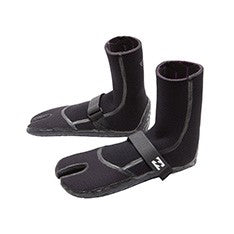
Split Toe Surf Boots
Like a round-toe surf boot, split toe wetsuit boots come in varying thicknesses. The difference with a split-toe design is that the big toe is separated from the others, giving you greater dexterity and a more natural, barefoot feel on your board. The separated big toe also helps to keep your boot secured in place, preventing it from sliding around your foot.
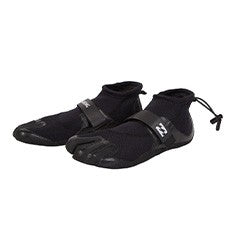
Reef Boots and Reef Surf Shoes
Feature a smooth, thin, vulcanized sole for flexible protection that gets you from A to B. They protect your feet from sharp coral reefs and rocks. Once in the lineup, you can either stash them in a wetsuit pocket or keep them on for added protection while surfing.
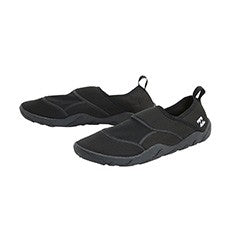
Reef Walkers
Are similar in design to reef surf booties. They are made to protect your feet from cuts and scratches when you’re surfing sharp reef or rocky areas, but also feature a textured sole for added traction when climbing over slippery surfaces. The thin sole is flexible enough to wear while surfing.
How Should Your Wetsuit Boots Fit
Try a boot that’s one size smaller than your shoe size. There should be absolutely zero room to move and should be as tight as possible without cutting off circulation.
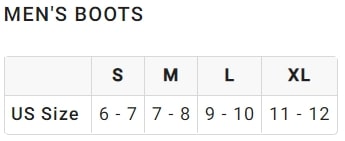
SHOP SURF BOOTIES
Surf Gloves: How To Pick Them
- Make sure gloves are the very last thing you put on before a surf session. Dexterity decreases significantly once your fingers are wrapped in a minimum of 3mm of rubber.
- In the coldest water (low 40°F and below), claw gloves are recommended. Keeping the fingers together allows for more collective body warmth and mitigates the chances of one or more isolated fingers freezing.
- Like hoods, wearing gloves while surfing also requires a learning curve. Paddling and pushing up off your board on takeoffs can feel much more restrictive.
Surf Glove Types

Five Finger Gloves
Aka full-finger gloves blend dexterity and warmth in water temps between 50°F-60°F.

Mitten Style
Surf mitts maximize warmth by combining the warmth of your fingers, minimizing the area exposed to cold water.
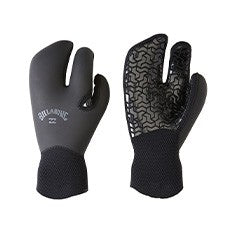
Claw Gloves
In the coldest water (low 40s and below), claw gloves are recommended. Keeping the fingers together allows for more collective body warmth and mitigates the chances of one or more isolated fingers freezing.
How Should Your Wetsuit Gloves Fit
Your wetsuit gloves should fit as snug as your wetsuit boots — as flush and tight as can be without cutting off circulation. To keep them as watertight as possible, make sure there is no extra room between the tips of the fingers and the gloves.
SHOP WETSUIT GLOVES
What To Look for in Wetsuit Hoods
Wetsuit hoods give you the best chance of a comfortable surf session once water temps dip to 57°F and below. Not only does a hood help insulate your head from wind-chill, it is your best way to combat the dreaded “ice cream headache” at surf spots requiring multiple duck dives. Here’s what to look for in an effective wetsuit hood:
- Hoods with thermal linings are again best for comfort and added warmth.
- Attached hoods on suits generally function best. If you have a detachable hood, we recommend one that covers your head and neck and has a flap that inserts inside your suit. This minimizes leakage.
- Wearing a hood while surfing may take some getting used to. Having the ears covered makes for a different experience and can initially throw off balance, conversations with others in the water, etc. In other words, you won’t be able to hear as well.
Wetsuit Hood Thickness
Wetsuit hoods, aka surf caps, come in varying thicknesses from 1mm to 5mm, although 2mm is standard and suitable for most cold-water sessions.
Types of Surf Hoods

Surf Cap
Covers the head and ears down to the nape of the neck. It features a short peak and chin strap and is ideal for extra warmth and protection from the sun and wind. Good for water temps 50°F-60°F.

Long Neck Surf Hood
Full head and ear coverage with an extended neck that inserts under your wetsuit collar to help prevent flushing. Good for water temps 48°F-60°F.

Hooded Wetsuit Vest
An integrated hood and sleeveless vest that you wear underneath your wetsuit for extra warmth and minimal flushing. Good for water temps 48°F-55°F.
How Should Your Wetsuit Hood Fit
A wetsuit hood should feel snug on your head but not too tight. It should form a tight seal around your face to keep the cold water from flushing in. Attached hoods on suits generally function best. If you have a detachable hood, we recommend one that covers your head and neck and has a flap that inserts inside your suit. This minimizes leakage.
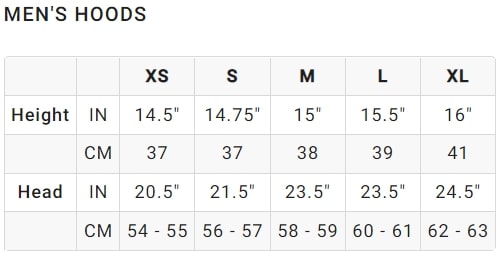
Wetsuit accessories are a great option for staying warm and enjoying the surf in colder conditions.












